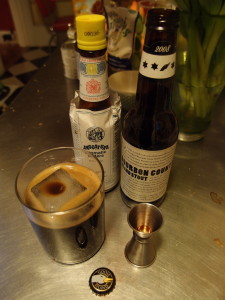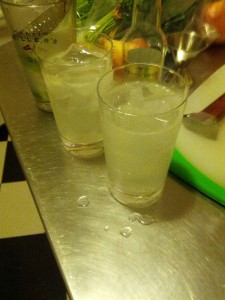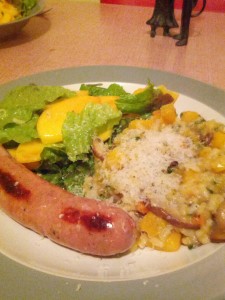A friend recently came back with some pictures from Pouring Ribbons in New York. Apparently, the talented bartenders there have been doing interesting things with ice.
In one case, they make puck shaped ice circles which nearly perfectly fit in an old fashioned type rocks glass. They build a portion of the drink, place the cube in the glass, then pour another portion of the drink on top of the cube. As the drink sits, the two parts slowly come together as the ice melts.
Dammit, Joaquin, you are making us look like we are not trying!
The idea of a drink that evolves as you consume it has always appealed to me, whether it was layers or flavors which come out as it warms, or through some other physical process.
At Alembic, where I sometimes work, they have been making ice made from water lightly flavored with cucumber for one of their drinks.
I like tea, so I was wondering about making ice from tea. Could you make a drink evolve by using ice made from strong tea?
I have a comical comment in my notebook, “Long Island Tea Ice,” which cracked me up when I first thought of it.
A few weeks ago, Erik Adkins had asked me about some posts I had written on eGullet in 2007 regarding the Rickey. I had to do some internet autopsy action to even remember what I had written.
The Rickey is a simple drink: Spirit, Lemon (or lime), and Soda. A very literal Highball with Lemon.
From Gary Regan’s writeup of the Rickey:
Whiskey Joe Rickey is Cool, Lemon or Lime
Joe Rickey disavowed the drink, though, saying in an interview published in an Ohio newspaper in 1900, “The ‘rickey’ originated in Washington, and I was in a sense responsible for it. You see, it was like this: I never drank whisky neat – it’s a mighty injurious system – but whisky diluted with a little water won’t hurt anybody. Of course, a carbonated water makes it brighter and more palatable, and for that reason I always took a long drink, usually whisky and water with a lump of ice.
“This is the highball of common commerce, and has been known to thirsty humanity for many generations. To this, however, I added the juice of a lemon in my desire to get a healthful drink, for the lemon acid is highly beneficial and tones up the stomach wonderfully.
“This combination became very popular at Shoomaker’s in Washington, where I did most of my drinking, and gradually the folks began asking for those drinks that Rickey drinks. About this time the use of limes became fairly common, and one afternoon an experimenter tried the effect of lime juice instead of lemon juice in the drink, and from that time on all ‘rickey’ were made from limes.
“I never drink the lime juice combination myself because I think the lemon acid is mellower and more beneficial.”
That may be, but the juice of a whole regular modern lemon makes for a pretty tart drink.
Thinking about that, myself, I thought of Meyer Lemons and their slightly lower acid content. Plus, I’ve always liked the gamey-thyme like flavor of their peel with Rye Whiskey.
Also, what if I upped the complexity of the drink a bit, by using the tea flavored ice?
If you’re using tea flavored ice, you might as well use a strong flavored tea…
Rye Whiskey Rickey, with Meyer Lemon and Tea Ice
1 1/2 oz Rye Whiskey
Juice 1 Meyer Lemon
1 Lapsang Souchong Tea Ice Cube*
Soda WaterPour the Rye Whiskey and Lemon over the ice cube in a highball glass (smallish is better, 8 oz is best). Stir briefly. Top with a little soda and stir once.
*Lapsang Souchong Tea is a black tea dried by smoking over a fire. It displays strong campfire notes. Brew a double strong batch of tea (2 tsp per cup) and pour into ice cube molds. Freeze.
At first you don’t really notice the smoke notes of the ice, but by the end, you wonder, “Is this a Scotch Rickey”?
Stay tuned for Long Island Tea Ice…




















